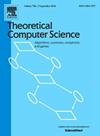On the geometric red-blue set cover problem
IF 0.9
4区 计算机科学
Q3 COMPUTER SCIENCE, THEORY & METHODS
引用次数: 0
Abstract
Using various geometric objects, we study variations of the geometric Red-Blue Set Cover (RBSC) problem in . Here, given two sets R and B of points, called red and blue points, respectively, and a set O of objects, the objective is to compute a subset of objects such that covers all the blue points in B and covers the minimum number of red points in R. We show that the RBSC problem with intervals on the real line is polynomial-time solvable. In , the problem admits a polynomial-time algorithm for a particular case of axis-parallel lines when no two lines intersect at a red point. However, if the objects are horizontal lines and vertical segments, the problem becomes -hard. It remains -hard for axis-parallel unit length segments distributed arbitrarily in the plane. The problem is -hard for the axis-parallel rectangles even when (i) each rectangle in O is anchored at one of the given two parallel lines, and (ii) a horizontal line intersects all the rectangles in O.
We show a variation of RBSC, called Special Red Blue Set Cover (SPECIAL-RBSC), to be -hard. Next, we use this result to show -hardness of the following geometric variations of RBSC problem in where the objects are (i) axis-parallel rectangles containing the origin, (ii) axis-parallel strips, (iii) axis-parallel rectangles that are intersecting exactly zero or four times, (iv) axis-parallel line segments, and (v) downward shadows of line segments, by providing the encoding of these problems as the Special Red Blue Set Cover problem. These -hardness results are in the same line of work by Chan and Grant (2014), who provided the -hardness results for the geometric set cover problem for the above classes of objects.
求助全文
约1分钟内获得全文
求助全文
来源期刊

Theoretical Computer Science
工程技术-计算机:理论方法
CiteScore
2.60
自引率
18.20%
发文量
471
审稿时长
12.6 months
期刊介绍:
Theoretical Computer Science is mathematical and abstract in spirit, but it derives its motivation from practical and everyday computation. Its aim is to understand the nature of computation and, as a consequence of this understanding, provide more efficient methodologies. All papers introducing or studying mathematical, logic and formal concepts and methods are welcome, provided that their motivation is clearly drawn from the field of computing.
 求助内容:
求助内容: 应助结果提醒方式:
应助结果提醒方式:


